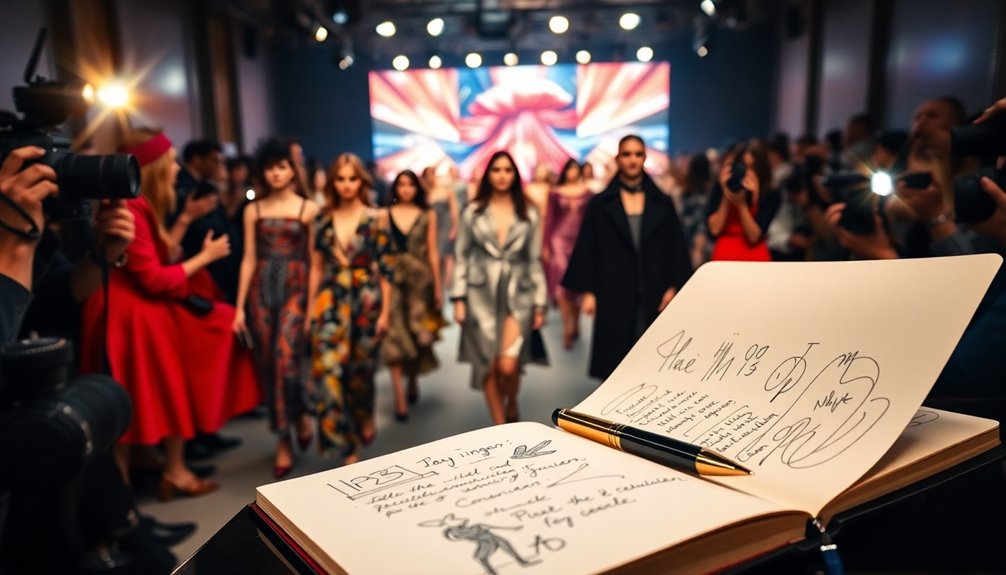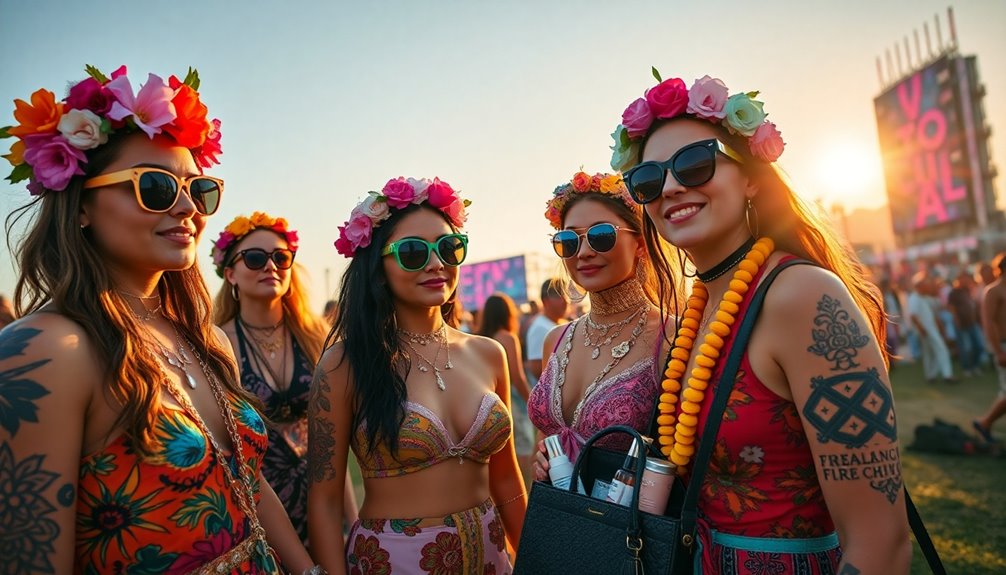To write a fashion runway review, start by understanding the designer's vision and the collection's theme. Set the scene with effective descriptions of the runway atmosphere. Highlight standout pieces and analyze their relevance. Use vivid language and sensory details to craft engaging narratives. Organize your review logically, ensuring a clear structure with an introduction, body, and conclusion. Incorporate quotes from the designer to enhance your insights and provide depth. Finally, revise for clarity and style, ensuring your critique is compelling and professional. The steps don't end here; there's more you can explore to refine your review.
Key Takeaways
- Begin with an introduction that provides context about the designer and the central theme of the collection.
- Analyze standout pieces, common traits, and the overall cohesiveness of the collection throughout the review.
- Incorporate sensory details, vivid language, and quotes from the designer to create an immersive narrative.
- Structure the review with clear main topics and ensure each paragraph focuses on a single idea for clarity.
- Proofread for grammatical consistency, seek feedback, and deliver the review promptly for relevance.
Understanding the Designer's Vision
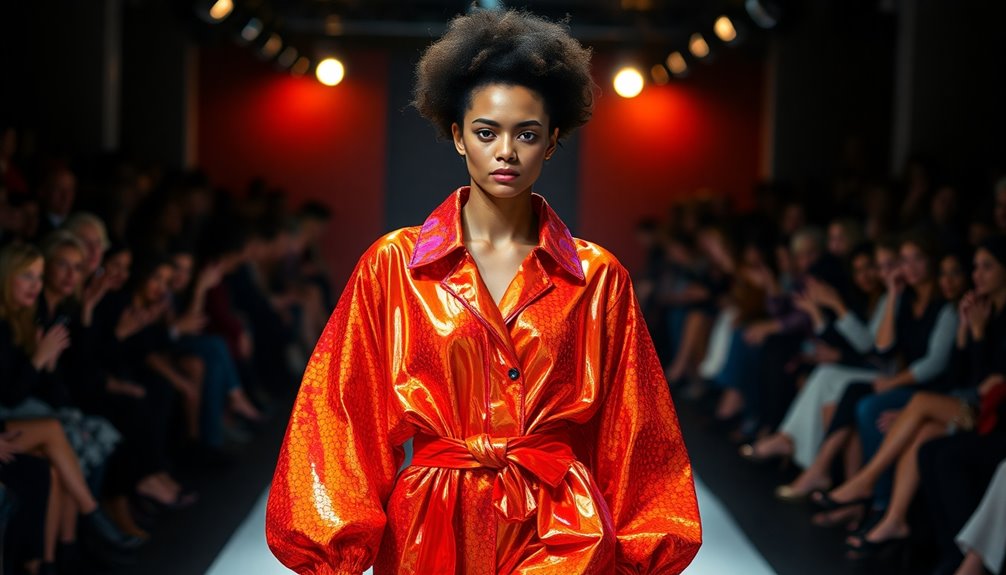
Understanding a designer's vision is crucial for crafting a thoughtful runway review. Start by identifying the central theme or concept of the collection. This theme serves as the backbone of the designer's work, guiding every piece shown on the runway.
Next, delve into the designer's inspirational background. Look for stories shared in the show notes or through PR representatives that reveal what motivated the collection. Pay attention to any cultural or historical influences that may have shaped the designs. This analysis can deepen your understanding of the collection's context.
Additionally, recognize any personal connections the designer might've woven into the pieces. These experiences can add layers of meaning to the collection. As you explore, track the designer's past works to see how they've evolved. Thorough research on the brand's history can also provide valuable insights into the designer's vision.
Identify trademark elements—such as cuts and silhouettes—that define their style. This helps you appreciate their unique approach while noting any new experiments they might be trying. By thoroughly understanding these facets, you'll be well-equipped to convey the essence of the collection in your review, capturing the designer's intent and the story they aimed to tell through their work.
Setting the Scene

The runway's set design plays a pivotal role in shaping the overall experience of a fashion show, creating a captivating backdrop that reflects the designer's vision. When you enter the venue, notice how the location often holds special significance, aligning with the collection's theme. Each element—from the choice of materials to the architectural details—works together to create an immersive environment.
As you observe the scene, the lighting and sound effects draw you in, enhancing the atmosphere and mood. Pay attention to the musical selection; it influences your emotional response and connects you to the narrative unfolding on the runway. The spatial planning is crucial, ensuring that every seat in the audience offers an optimal view while maximizing interaction.
Set designers collaborate closely with architects and fashion designers, merging creativity and technical expertise. This partnership brings forth unique designs that enhance brand identity and create memorable moments. Curating and collaborating on the set design ensures that every detail is in line with the overarching vision presented during the show.
As you analyze the set, consider how it incorporates historical references or thematic elements, inviting you into a world that transcends mere clothing, making the entire experience unforgettable.
Analyzing the Collection
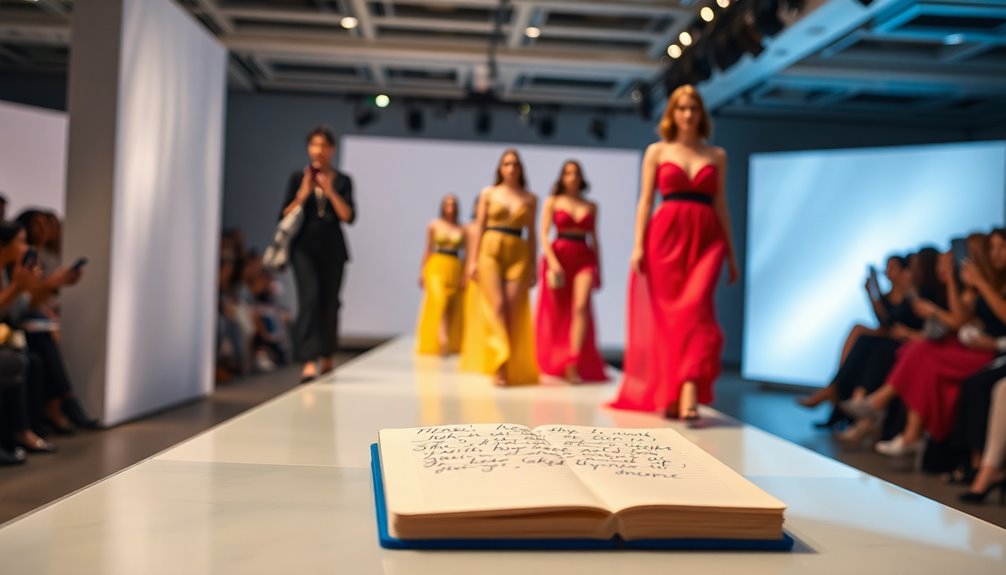
Dive into the collection by exploring its theme and inspiration. Start by identifying the designer's motive—what message are they conveying? Look for historical, cultural, or social influences that shaped the collection's concept. Highlight standout pieces that truly embody this theme; these will often serve as the collection's focal points.
Next, note common traits throughout the collection, such as recurring colors, prints, or silhouettes. Consider how these elements contribute to the overall aesthetic and narrative. Pay attention to how the collection reflects or challenges current cultural norms and trends. The historical insights gained from understanding clothing evolution can greatly enhance your analysis of these elements.
As you analyze, think about how the pieces work together. Does the collection maintain a cohesive look? Look for a progression from the opening look to the finale—does it build in drama or intensity? Examine the transitions between pieces and how they create a seamless flow.
Finally, assess the collection's impact. Identify both the high and low points, evaluating which looks resonate and which fall flat. This comprehensive analysis will help you capture the essence of the collection in your review.
Crafting Descriptive Narratives
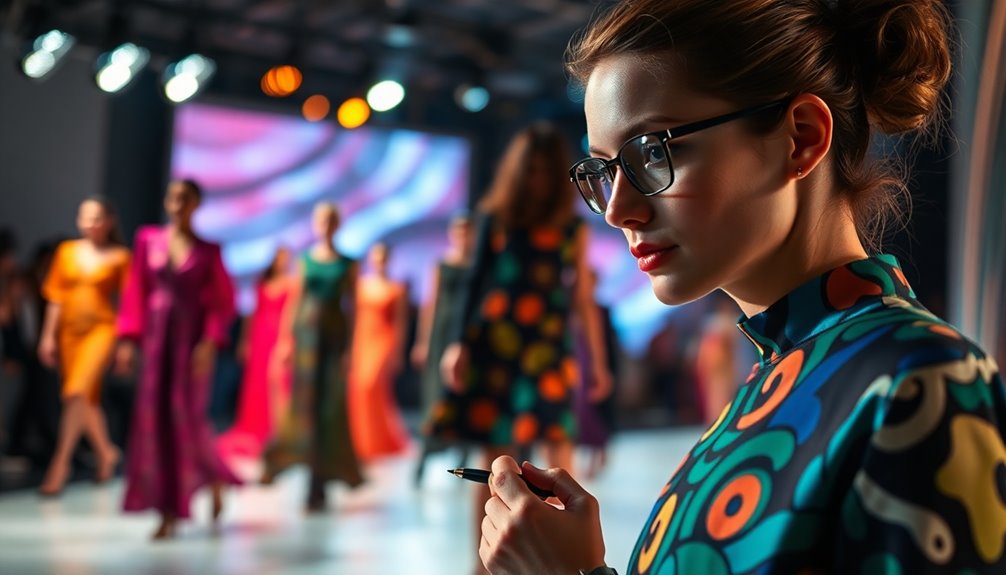
Crafting descriptive narratives in fashion runway reviews transforms a simple observation into an immersive experience. To achieve this, use vivid language that paints a picture in the reader's mind. Metaphors and similes, like "the model's dress shimmered like a moonlit night," can enhance your descriptions significantly.
Don't shy away from personification, either; for example, "the runway lights danced across the catwalk" adds a dynamic quality to your writing.
Engage your audience's senses by incorporating sensory details. Describe the rustle of silk as the model walks, or how the intricate embroidery sparkles under the lights. Vivid adjectives such as "sleek" or "elegant" can elevate your descriptions further. Characters in fashion, such as the models, play a crucial role in conveying the designer's vision and emotional impact.
Building a narrative is paramount. Share the designer's inspiration, weaving a story with a clear beginning, middle, and end. Highlight the models, the setting, and any themes or conflicts present in the collection.
Use symbolism, like how red embodies passion, to deepen your analysis. Lastly, including quotes from the designer or insights from backstage can enrich the narrative, making your review not just informative but truly captivating.
Organizing Your Review
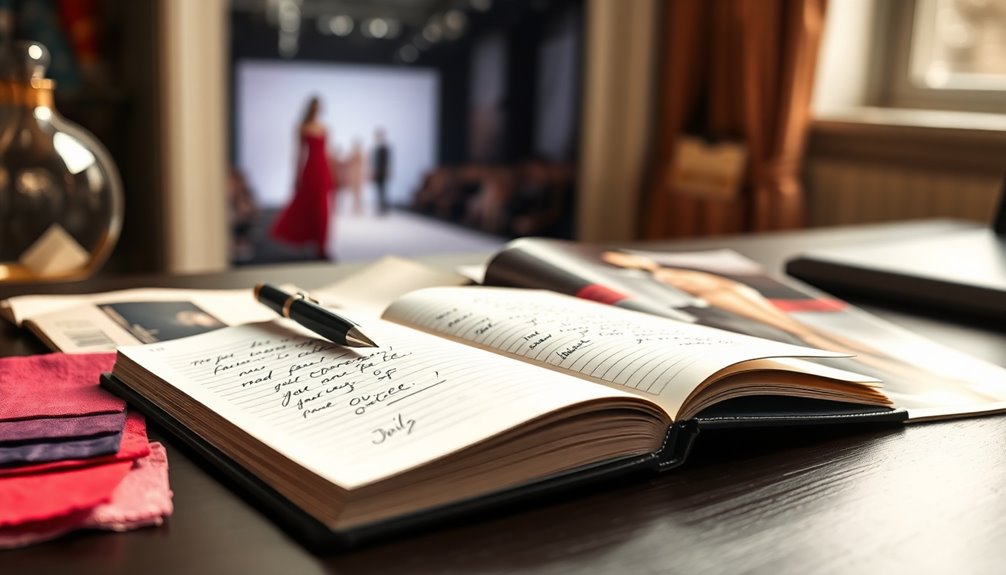
When organizing your fashion runway review, think of it as constructing a compelling narrative. Start with an introduction that sets the stage, providing context about the designer's inspiration and the collection's target audience. This helps your readers understand the essence of what you're about to discuss.
Next, dive into the body of your review, using a clear structure. Each paragraph should tackle a single main topic, whether it's the color palette, textures, silhouettes, or the overall mood of the show. You might want to arrange these topics in an order that keeps your reader engaged, perhaps starting with the most visually striking elements.
Don't forget to include details like notable looks and any VIPs present at the show. This adds richness to your review and connects with the broader cultural context. Additionally, creating an outline can enhance clarity and coherence in your writing, allowing for a more organized presentation of your thoughts.
Finally, wrap up with a conclusion that reflects on the collection's significance and how it fits into the designer's previous work. Using an outline throughout the process will help keep your thoughts organized and ensure that your review flows smoothly from beginning to end.
Adding Depth With Quotes
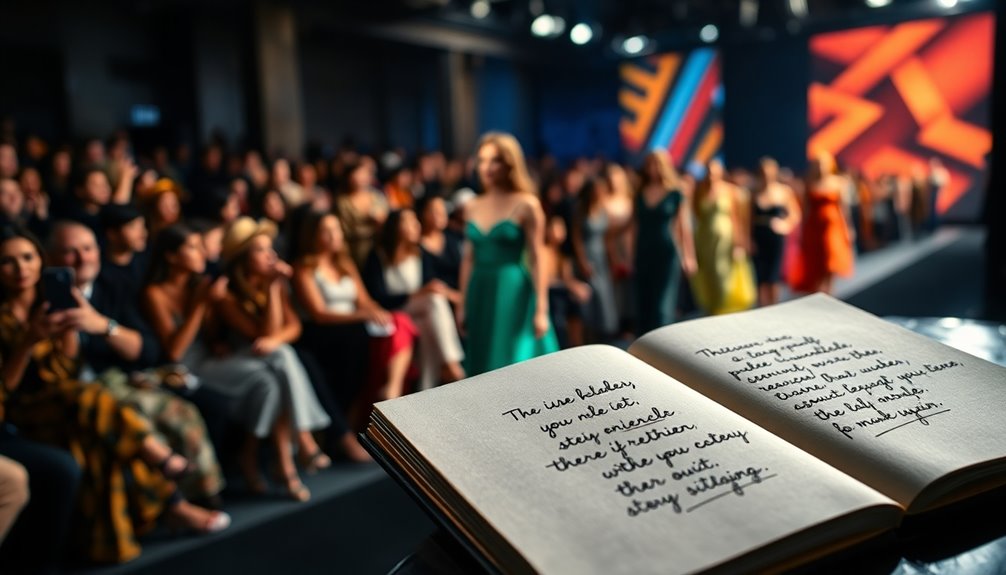
To enrich your fashion runway review, integrating quotes from the designer can provide valuable insights and enhance your narrative. Start by sourcing quotes from show notes, media releases, or backstage interviews. These direct insights can help explain the designer's inspiration and the overarching message of the collection.
Choose quotes that clarify the collection's themes, focusing on elements like color palette and silhouette. Make sure the quotes are clear and concise—short statements often have a more significant impact. Additionally, consider how the collection's commentary on current societal issues can deepen the understanding of the designer's intent.
Balance the quotes with your analysis to create a cohesive review that reflects your voice alongside the designer's. Strategically place quotes to enhance key points, whether at the beginning to set the tone or at the end to summarize your thoughts.
Ensure the flow of your review remains intact; quotes should serve as connectors between sections. Always attribute quotes to the correct source, maintaining credibility and engaging your readers further.
Incorporating Visual Elements

Incorporating visual elements into your fashion runway review not only enhances the narrative but also captivates your readers. Start by including images that showcase the clothing in real-life scenarios. These visuals help your audience visualize how the pieces might fit into their wardrobe. Keep in mind that customer images can significantly influence purchase decisions, as they often feel more authentic than brand photos.
When describing the runway and set, paint a vivid picture of the atmosphere. Mention unique details, like the creative backdrop or the energy in the room, and how it complements the collection. Highlight the thematic elements, colors, and textures that align with the designer's vision. Additionally, remember that visual representation aids in understanding product fit and style, making your review even more impactful.
Don't forget to focus on standout garments and accessories. Discuss how the styling—like hair, nails, and makeup—adds to the overall presentation. This attention to detail not only engages your readers but also enhances the authenticity of your review.
Finally, consider using user-generated content if possible, as it resonates well with millennials and boosts engagement and conversion rates. By integrating these visual elements, your review will be both informative and appealing.
Revising and Finalizing Your Review
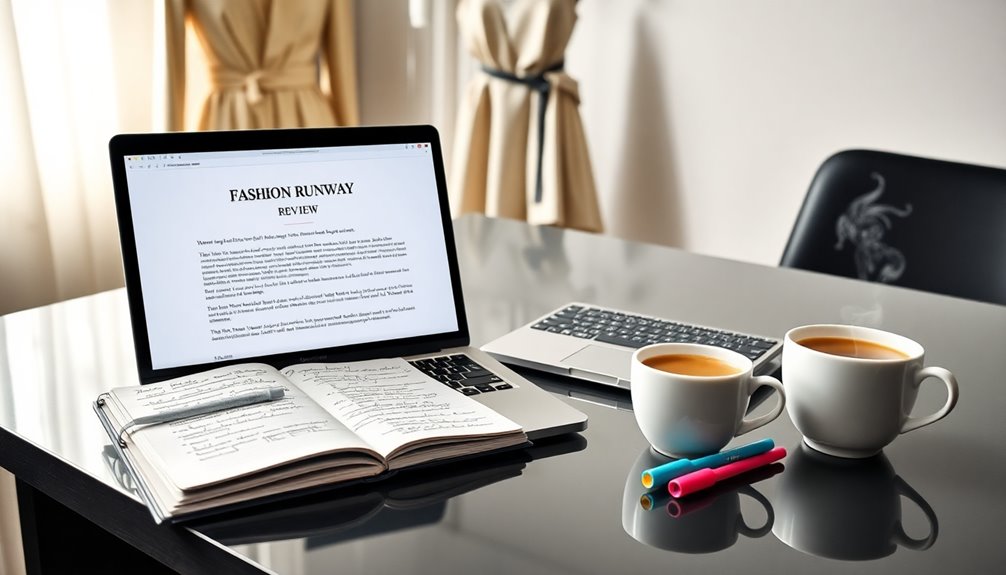
As you dive into revising and finalizing your fashion runway review, it's crucial to ensure that your structure flows seamlessly. Start by confirming that your review has a clear beginning, middle, and end. Each paragraph should focus on one main topic, allowing readers to easily digest your insights. If necessary, rearrange paragraphs to enhance the logical order of the information.
Next, evaluate the content depth. Make sure you've provided enough context about the designer's inspiration while detailing standout pieces, accessories, and the overall atmosphere of the show. Analyze the collection's common traits and trends, ensuring you comment on its cohesiveness and balance. Prior knowledge of the designer's past work will aid in your evaluation of the new collection.
Then, enhance clarity and precision. Use vibrant language to describe outfits while avoiding vague opinions. Instead, provide thoughtful critiques that demonstrate your understanding of the collection. Keep sentences short and clear to maintain the reader's interest, and eliminate any repetitious phrases.
Finally, proofread your work for grammatical errors and consistency. Consider having someone else review your draft for additional insights. Aim to finalize your review promptly, delivering fresh news to your readers right after the show.
Frequently Asked Questions
How Do I Choose Which Fashion Shows to Review?
To choose which fashion shows to review, start by focusing on those that align with current trends or cultural movements.
Look for collections by influential designers, whether established or emerging.
Consider shows that introduce innovative concepts or have gained media buzz.
Seasonal importance is key, so prioritize major fashion weeks.
Finally, evaluate the show's production value, as striking visuals and talented models enhance the overall experience and attract your readership.
What Should I Wear to a Fashion Show?
When you're heading to a fashion show, dress appropriately to reflect both your personal style and the event's essence.
Choose polished outfits that photograph well and avoid anything that might block others' views, like large hats. If possible, wear a piece from the designer to show support.
Remember to arrive on time, and keep your interactions genuine and respectful, ensuring you engage fully with the presentation.
Enjoy the experience!
How Can I Improve My Fashion Writing Skills?
To improve your fashion writing skills, start by immersing yourself in the industry. Read fashion magazines, blogs, and follow influencers to grasp different styles.
Practice writing regularly, whether through a blog or journaling. Seek feedback to refine your grammar and vocabulary.
Attend fashion events for firsthand experience, and analyze how various publications structure their articles.
Networking with industry professionals can also open doors and provide insights to elevate your writing.
Are There Specific Etiquette Rules for Attending Fashion Shows?
Absolutely, there are specific etiquette rules for attending fashion shows. You should always dress formally, with men in dark suits and women in elegant dresses.
Arrive on time to avoid disruptions, and stay seated during the show to respect others' views. Keep your devices on silent and avoid flash photography.
Remember to applaud at the end to appreciate the designers' work. Most importantly, enjoy the experience while being courteous to fellow attendees!
How Do I Network With Industry Professionals at Shows?
To network with industry professionals at shows, start by researching attendees and preparing your introduction.
Dress to impress and arrive early to mingle. Initiate conversations casually, showing genuine interest in others by asking thoughtful questions.
Balance talking about yourself with listening. Exchange contact information and follow up promptly after the event.
Engage on social media and suggest future collaborations to keep the connection alive. Make every interaction meaningful to build lasting relationships.
Conclusion
In conclusion, writing a fashion runway review is all about capturing the essence of the designer's vision and the collection. By blending descriptive narratives with thoughtful analysis, you create an engaging piece that resonates with readers. Don't forget to sprinkle in quotes and visuals to enhance your review's depth. With practice and careful consideration, you'll refine your voice and style, making your reviews not just informative but also a pleasure to read. Happy writing!
